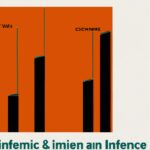The Gini Coefficient gauges income inequality. Lower figures reflect more equality, with zero depicting total equality. Various nations utilize this metric to examine societal disparities and craft policies fostering equitable wealth distribution. In Sweden, a low coefficient indicates a more equal society, supported by progressive taxation and robust social welfare programs. South Africa faces high inequality, influenced by a history of apartheid and economic disparities. China’s coefficient has risen due to rapid economic growth, yet rural-urban divisions persist. Each country’s unique context shapes the Gini Coefficient’s application and highlights the ongoing global challenge of addressing income inequality.
Table of Contents
- Calculation method of Gini Coefficient
- Comparison of income inequality using Gini Coefficient across different countries
- Criticisms of Gini Coefficient
- Definition of Gini Coefficient
- Factors affecting income inequality in different countries
(Understanding the Gini Coefficient)
The Gini coefficient, a measure of income inequality, varies across countries worldwide. Developed nations typically exhibit lower Gini coefficients compared to developing countries. In Scandinavian countries like Norway and Sweden, the Gini coefficient is relatively low due to their strong social welfare systems. These nations prioritize implementing policies that promote income equality. In contrast, countries in Latin America, such as Brazil and Colombia, have higher Gini coefficients, indicating greater income inequality. Factors like historical wealth distribution and economic policies influence these disparities. Developing nations often face challenges in reducing income inequality due to limited resources. Effective redistribution strategies can help alleviate disparities and improve living standards. Governments can implement progressive taxation, social welfare programs, and educational initiatives to address income inequality. The Gini coefficient serves as a valuable tool for policymakers to evaluate the effectiveness of income distribution policies. By analyzing and understanding the Gini coefficient, countries can strive towards a more equitable society. Collaboration and data sharing between nations can further enhance efforts to combat income inequality on a global scale.
Calculation method of Gini Coefficient
When it comes to understanding economic inequality within a country, the Gini Coefficient is a valuable tool. This coefficient provides us with a numerical representation of income distribution and can help policymakers make informed decisions on how to address disparities. One crucial aspect of utilizing the Gini Coefficient is knowing how to calculate it accurately.
The calculation method of the Gini Coefficient involves plotting individuals’ cumulative income shares against the cumulative population. Imagine lining up all citizens from poorest to richest and then graphing their share of total income as you move along this line – that’s essentially what calculating the Gini Coefficient entails.
To start, we need precise data on each individual’s income in the population being analyzed. Once we have these figures, we arrange them in ascending order, starting with the lowest-income earner up to the highest-earning individual.
Next, we create another column showing what percentage of total income each person holds cumulatively going down our list. This step helps visualize how evenly or unevenly wealth is distributed among society members.
After plotting these points on a graph where one axis represents cumulative population percentages and the other shows corresponding income shares, we draw a line connecting all points forming an area known as “the Lorenz curve.”
Calculating the actual Gini Coefficient value involves comparing this Lorenz curve against perfect equality (where every citizen earns an equal amount) represented by a diagonal line running from 0% at both axes’ origin to 100%.
By finding out how much area lies between these two lines relative to total area under perfect equality (which equals 0.5), we arrive at our final Gini Coefficient figure ranging from 0 (perfect equality) to 1 (maximum inequality).
Understanding this method not only allows researchers and policymakers across different countries to assess their nations’ economic conditions but also helps identify where interventions may be most needed for creating more equitable societies.
In conclusion, mastering the calculation method of the Gini Coefficient is essential for anyone interested in tackling economic inequality effectively — it serves as a compass guiding towards fairer distributions for all people living in various corners of our world.
Comparison of income inequality using Gini Coefficient across different countries
Income inequality is a pressing issue worldwide, and the Gini Coefficient serves as a crucial tool in quantifying and comparing this disparity among different countries. The Gini Coefficient ranges from 0 (perfect equality) to 1 (maximum inequality), offering a snapshot of how wealth is distributed within a nation.
Let’s delve into the comparison of income inequality using the Gini Coefficient across various countries, shedding light on the socioeconomic landscapes shaping these disparities.
In Sweden, known for its robust social welfare system, the Gini Coefficient hovers around 0.25, showcasing relatively low income inequality. This reflects extensive government intervention through progressive taxation and comprehensive public services aimed at narrowing wealth gaps and ensuring social equity.
Contrastingly, Brazil grapples with significant income disparity, boasting a Gini Coefficient surpassing 0.50. Here, stark divisions between rich and poor underscore systemic challenges that hinder equal opportunities for all citizens. The struggle against poverty remains an uphill battle despite ongoing efforts to address economic inequities.
Moving eastward to China unveils a complex narrative of rapid growth alongside widening income gaps. With a Gini Coefficient nearing 0.40, China navigates the tensions between prosperity-driven development and equitable wealth distribution amid urban-rural divides and varying regional realities.
Meanwhile, in Norway—a beacon of egalitarian principles—the Gini Coefficient lingers near 0.27 due to inclusive policies prioritizing social welfare, education accessibility, and healthcare provisions that uplift marginalized populations while promoting shared prosperity across society.
Each country’s unique blend of historical legacies, policy frameworks, cultural norms interplay in shaping their respective levels of income inequality captured by the nuanced lens of the Gini Coefficient.
Through this comparative exploration spanning diverse global contexts—from Scandinavia to South America—emerges a poignant mosaic illustrating how nations grapple with economic disparities impacting their societal fabric profoundly.
At its core lies not just numerical data but human stories intertwined with hopes for greater fairness justice underscoring our collective pursuit for more equitable world where every individual can thrive regardless backgrounds or circumstances they come from.
Criticisms of Gini Coefficient
The Gini Coefficient, while widely used to measure income inequality in different countries, has faced its fair share of criticisms. One major critique is that it oversimplifies complex social structures by reducing them to a single number. It fails to capture the nuances and intricacies of wealth distribution within societies.
Critics argue that the Gini Coefficient does not consider factors such as regional disparities, access to healthcare and education, or intergenerational wealth transfer. These omissions can mask inequalities that exist at a more localized level, giving an incomplete picture of overall societal inequality.
Moreover, some critics point out that the Gini Coefficient ignores non-monetary forms of wealth or well-being, such as quality of life indicators or social mobility opportunities. This limitation can lead to a skewed understanding of true equality within a society.
Another criticism is related to data accuracy and reliability. Inaccurate reporting of incomes or lack of transparency in data collection methods can result in misleading Gini Coefficients that do not reflect the actual income distribution accurately. This flaw undermines the credibility and usefulness of the coefficient as a tool for policy-making and decision-making processes.
Furthermore, critics raise concerns about how changes in population demographics over time can impact the validity of comparing Gini scores across different periods. Without accounting for shifts in population dynamics like aging populations or migration patterns, interpretations based on historical Gini values may be flawed.
Despite these criticisms, proponents argue that while imperfect, the Gini Coefficient still serves as a valuable starting point for understanding income inequality trends globally. When used alongside other metrics and qualitative research methods, it can provide insights into areas needing attention and help policymakers design targeted interventions for addressing systemic inequalities effectively.
In conclusion, while acknowledging its limitations and pitfalls is essential when using the Gini Coefficient as an analytical tool; its continued application under nuanced scrutiny could pave the way for more comprehensive assessments towards creating fairer societies worldwide.
(Is inequality inevitable?)
Definition of Gini Coefficient
The Gini coefficient is like a mirror reflecting the distribution of wealth within a country. It’s this mathematical measure that lays bare the economic disparities and inequalities among its people. Think of it as a scorecard that reveals whether prosperity is shared fairly or concentrated in the hands of a few.
Imagine a spectrum where 0 represents perfect equality, meaning everyone has an equal share of wealth, while 1 signifies extreme inequality with all the riches held by one person. The Gini coefficient gives us a number between these two extremes to show how close or far a nation is from achieving equitable distribution.
In essence, it quantifies social justice on an economic scale, showing us who benefits most from financial growth and development in society. When you see countries with low Gini coefficients, it signals greater equality among their citizens—think Finland or Denmark where resources are more evenly spread out.
On the flip side, high Gini coefficients reveal deep divides between rich and poor—a reality faced by many nations worldwide. Countries like South Africa or Brazil struggle with soaring income gaps, fueling societal tensions and hindering overall progress towards collective well-being.
By delving into this numerical snapshot provided by the Gini coefficient, policymakers gain valuable insights into areas needing attention for creating fairer societies. Governments can use this data to tailor policies aimed at redistributing wealth more equitably across different segments of the population.
So next time you hear about the Gini coefficient being bandied about in discussions on economics or social justice issues, remember—it’s not just another abstract statistic but rather a powerful tool shedding light on who reaps the rewards of economic growth and who gets left behind in its shadow.
Factors affecting income inequality in different countries
Income inequality is a complex issue that varies significantly across different countries. Several factors contribute to the disparity in income distribution, impacting how wealth is shared among individuals within a society.
One crucial factor influencing income inequality is education levels. Countries where access to quality education is limited tend to experience higher levels of income inequality. Education plays a vital role in providing individuals with skills and opportunities for better-paying jobs, creating a cycle where those with higher education levels earn more than those without.
Economic policies also play a significant role in shaping income inequality. Taxation policies, minimum wage laws, and social welfare programs can either mitigate or exacerbate income disparities within a country. For instance, progressive tax systems that tax higher earners at a greater rate can help redistribute wealth and reduce income inequality.
The structure of the labor market is another critical determinant of income distribution. In economies dominated by low-skilled industries or characterized by high rates of unemployment, it’s common to see wider gaps between the rich and the poor. Conversely, countries with diverse job markets offering various opportunities for skill development are likely to have lower levels of income inequality.
Globalization and technological advancements have also impacted income distribution worldwide. While globalization has led to increased economic growth in many regions, it has also contributed to widening wage gaps between different sectors of society. Additionally, automation and digitalization have displaced certain job categories while creating new roles that require specific skill sets.
Cultural norms and social attitudes towards wealth can further perpetuate or challenge income inequality within societies. In some cultures, individual success and accumulation of wealth are highly valued, leading to greater disparities between the affluent and the impoverished members of society.
Overall, understanding the multifaceted nature of factors influencing income inequality is crucial for policymakers aiming to address this pressing issue on both national and international scales.













